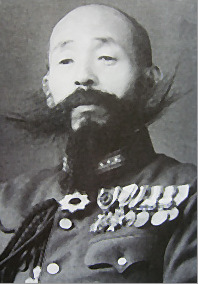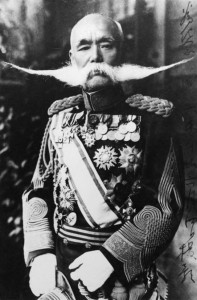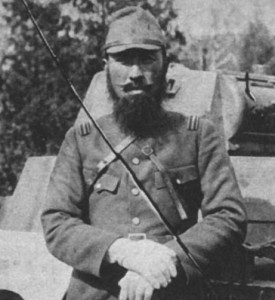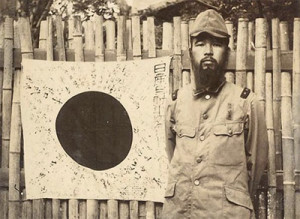A Bearded Army
- By Peter Harmsen
- 22 February, 2014
- 2,147 Comments
 When Japanese tank commander Fujita Sanehiko, pictured left, took part in the campaign in central China in late 1937, he was well-known back home. A gifted writer, he sent dispatches from the frontline that were widely read by a public generally supportive of the war against the giant neighbor across the sea. Whether Fujita was also famous for his flamboyant appearance, especially his huge facial hair, is less certain.
When Japanese tank commander Fujita Sanehiko, pictured left, took part in the campaign in central China in late 1937, he was well-known back home. A gifted writer, he sent dispatches from the frontline that were widely read by a public generally supportive of the war against the giant neighbor across the sea. Whether Fujita was also famous for his flamboyant appearance, especially his huge facial hair, is less certain.
Maybe not. Luxuriant beards and outlandish moustaches flourished in the Japanese Army (less so in the Navy), and had done so since the late 19th century (see picture to the right). This was especially so in times of war, when lack of facilities, including something as basic as hot water, made shaving less convenient than back at the barracks.
But it was more than that. For Japanese soldiers, growing a beard seems to have been a rite of passage, and a sign of masculinity. Tamai Katsunori, a soldier who took part in the last stages of the battle of Shanghai in 1937, reported entering into a competition with his fellow soldiers about who could grow the longest beard. The fact that big beards are not very common among the Chinese may have acted as a further incentive among the Japanese soldiers to put the razor away.
It may also have signaled a changed mental state. Many veterans report an intoxicating feeling of complete freedom in the war zone. It’s a feeling that they have never experienced before or after, of being in a position to do whatever one likes, to whomever one likes, liberated from any of the usual social constraints. This may be part of the explanation why atrocities such as the Nanjing massacre could happen.
The brutal truth is that doing away with the ways of civilized society and returning to the simpler ethical choices faced by the caveman may actually help the soldier, as an aggressive and violent attitude enables him not just to do his job, but also simply to survive under intensely hostile battlefield conditions.

 Copyright © 2024
Copyright © 2024
Leave a Reply